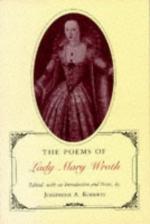|
This section contains 10,484 words (approx. 35 pages at 300 words per page) |

|
SOURCE: “‘This Strang Labourinth’: Lady Mary Wroth,” in Women Writers of the English Renaissance, Twayne Publishers, Inc., 1996, pp. 170-90.
In the following essay, Walker explores the ways in which Wroth manipulated genre conventions and gender ideology.
Isabella Whitney's miscellanies and Mary Fage's acrostics manipulate genre so that it can accommodate the work of these industrious women. The writing of Lady Mary Wroth, niece of the Countess of Pembroke, provides us with a rather different but perhaps even more bold manipulation of genre.1 Wroth is particularly significant because she chose to write in courtly genres that were traditionally the preserve of male writers—romance (The Countesse of Mountgomeries Urania), sonnet sequence (Pamphilia to Amphilanthus), and pastoral tragicomedy (Love's Victorie).2 The publication of her romance and sonnet sequence in 1621 violated the aristocratic codes of manuscript circulation with sensational results. The literary quarrel that ensued focused attention on Wroth's sex as...
|
This section contains 10,484 words (approx. 35 pages at 300 words per page) |

|


